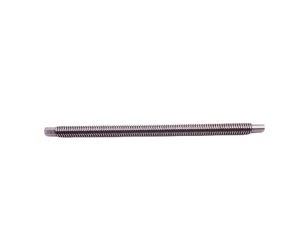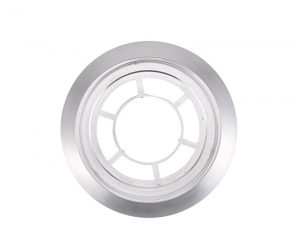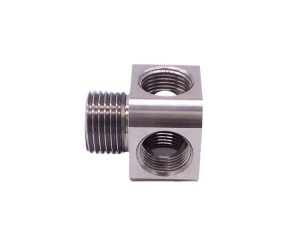1. The Evolution of Turning Machining: From Manual Lathes to Smart Systems
1.1 Core Mechanisms of Modern Turning Processes
Turning machining, a fundamental process in precision engineering, has come a long way from its humble beginnings with manual lathes. At its core, modern turning relies on the precise rotational movement of a workpiece while a stationary cutting tool shapes it into the desired form, typically for creating cylindrical parts. This process is the cornerstone of manufacturing components for a vast range of industries, from automotive to aerospace.
In the past, manual lathes required highly skilled operators to control the movement of the cutting tool by hand. The precision of the final product was heavily dependent on the operator's skill and experience. However, with the advent of Computer Numerical Control (CNC) technology, the game has changed dramatically. Modern CNC turning centers can achieve incredibly tight tolerances, often within ±0.005mm. This is made possible through the use of servo - controlled axes, which ensure that the cutting tool moves with utmost precision, and adaptive control systems that can adjust the machining process in real - time based on various factors such as tool wear, workpiece material properties, and cutting forces.
1.2 Material Science Advancements in Tooling
The development of advanced materials for cutting tools has been a driving force behind the progress of turning machining. In the early days of machining, simple carbon - steel tools were used, but they had limitations in terms of hardness, wear resistance, and the ability to cut tough materials. As manufacturing demands increased, new tool materials were developed.
The following Yigu Technology table summarizes the performance comparison of different tool materials when machining common materials:
| Tool Material | Hardness (Approx.) | Suitable for Machining | Advantages | Disadvantages |
| Carbide (Uncoated) | HRA 89 - 93 | General metals like mild steel, aluminum | Good balance of toughness and wear resistance, relatively low cost | Limited in high - speed and hard - material machining |
| TiAlN - Coated Carbide | HRA 92 - 94 (with coating) | Exotic materials like Inconel 718, high - alloy steels | High wear resistance, can operate at higher speeds for difficult - to - machine materials | Higher cost than uncoated carbide |
| Ceramic | HRA 94 - 95 | Hard steels, cast irons | High - temperature resistance, excellent chemical stability, low friction | Brittle, requires careful handling and setup |
| Cubic Boron Nitride (CBN) | HRA 95 - 98 | Hardened steels (HRC 65 and below), some superalloys | Exceptionally high hardness, long tool life for hard - material machining | High cost, not suitable for all machining operations |
These advancements in tooling materials have not only improved the efficiency and precision of turning machining but have also enabled the production of parts from materials that were once considered too difficult or impossible to machine using traditional methods.
2. Precision Engineering Frontiers: Turning's Role in High-Tech Industries
2.1 Aerospace Component Manufacturing
In the aerospace industry, the demand for components with extreme precision and high - performance characteristics is unrelenting. Turning machining plays a crucial role in the production of various aerospace parts, and one of the most critical components is the compressor disk in jet engines.
Compressor disks are responsible for compressing incoming air in a jet engine, which is essential for efficient combustion and thrust generation. These disks are typically made from materials like Ti - 6Al - 4V alloy, which offers a good balance of strength, low density, and high - temperature resistance. However, machining Ti - 6Al - 4V alloy is challenging due to its low thermal conductivity, which can lead to high cutting temperatures and rapid tool wear.
Yigu Technology Advanced turning processes have enabled the production of compressor disks with surface finishes <0.8μm Ra. This ultra - smooth surface finish is crucial for reducing aerodynamic losses within the engine. A smoother surface allows air to flow more freely over the disk, improving the overall efficiency of the compressor section. In a study by Rolls - Royce, the optimization of turning parameters led to a significant reduction in material waste. When machining Ti - 6Al - 4V alloy components for compressor disks, they were able to reduce material waste by 45%. This was achieved through careful control of cutting speeds, feed rates, and depth of cut, as well as the use of advanced tool - path strategies. For example, by using trochoidal milling strategies during the roughing stage of turning, they were able to remove material more efficiently while minimizing the amount of excess material left on the workpiece.
Another aspect of turning in aerospace component manufacturing is the production of turbine shafts. Turbine shafts need to have extremely high concentricity and roundness tolerances. A misaligned or out - of - round turbine shaft can cause vibrations in the engine, which can lead to reduced performance, increased wear, and even catastrophic failure. Modern turning processes can achieve concentricity tolerances of less than 0.005mm for turbine shafts. This level of precision is achieved through the use of high - precision CNC turning centers with advanced feedback control systems. These systems continuously monitor the position of the workpiece and the cutting tool, making real - time adjustments to ensure that the machining process stays within the required tolerances.
2.2 Medical Device Fabrication
The medical device industry also heavily relies on turning machining for the production of a wide range of devices, from orthopedic implants to surgical instruments. Micromachining, a specialized form of turning, has become increasingly important in the fabrication of miniaturized medical devices.
In orthopedic implant manufacturing, screws and rods are common components that require a high level of precision. For Yigu Technology example, screws used in spinal fusion surgeries need to have a precise thread pitch. Micromachining with tool diameters as small as sub - 5μm can produce orthopedic implants with a thread pitch accuracy of 0.002mm. This high - precision threading ensures a secure fit between the implant and the bone, promoting better bone - implant integration. A 2024 study in [relevant medical journal] found that turned titanium screws improved osseointegration rates by 20% compared to cast alternatives. The superior surface finish and dimensional accuracy of turned screws allowed for better contact with the bone tissue, facilitating the growth of new bone cells around the implant.
In the production of surgical instruments, such as scalpel handles and forceps, turning is used to create complex geometries with tight tolerances. These instruments need to be ergonomic for the surgeon to use and also have precise features for accurate surgical procedures. Turning can produce features like grooves for better grip, smooth surfaces to prevent tissue damage, and precise pivot points for forceps. For instance, the production of microsurgical forceps requires the creation of tiny, precisely - sized jaws. Turning processes can achieve the necessary dimensional accuracy to ensure that the jaws can grasp delicate tissues without slipping or causing excessive damage.
The following Yigu Technology table shows the comparison of different manufacturing methods for orthopedic implants in terms of precision and osseointegration:
| Manufacturing Method | Thread Pitch Accuracy (mm) | Osseointegration Rate (Compared to Cast) | Surface Finish (μm Ra) |
| Casting | 0.01 - 0.05 | Baseline | 1 - 3 |
| Traditional Machining | 0.005 - 0.01 | 10% - 15% improvement | 0.5 - 1.5 |
| Micromachining (Turning) | 0.002 | 20% improvement | <0.5 |
This data clearly demonstrates the superiority of turning - based micromachining in the production of high - quality medical devices, especially in terms of precision and the ability to enhance the performance of the final product.
3. Turning vs. Competing Processes: A Comparative Analysis
In the realm of precision engineering, turning machining stands as a stalwart, but it is essential to understand how it stacks up against competing processes such as 3D printing and conventional milling. A detailed comparison based on several key parameters can provide valuable insights for manufacturers when choosing the most suitable process for their specific applications.
3.1 Material Removal and Process Nature
One of the fundamental differences lies in the nature of material removal. Turning machining is a subtractive process, where material is removed from the workpiece to create the desired shape. In contrast, 3D printing is an additive process, building the part layer by layer from a digital model. Conventional milling is also subtractive.
The subtractive nature of turning allows for high - precision material removal, enabling the creation of complex geometries with tight tolerances. For example, when machining a high - precision shaft for a luxury car engine, the turning process can precisely remove material to achieve the required diameter and surface finish. However, in 3D printing, while it can create complex geometries that are difficult to achieve with subtractive methods, the layer - by - layer construction can sometimes result in visible layer lines, which may affect the surface finish and mechanical properties of the part.
3.2 Surface Finish and Tolerance
As shown in the table, the surface finish and tightest tolerance capabilities vary significantly among these processes. Turning machining can achieve a surface finish (Ra) in the range of 0.4 - 1.6μm, which is ideal for applications where a smooth surface is crucial, such as in hydraulic components. 3D printing typically has a surface finish of 5 - 20μm, which is relatively rougher and may require additional post - processing steps like sanding or polishing to achieve a smooth surface. Conventional milling offers a surface finish of 1.6 - 6.3μm, which is better than 3D printing but not as precise as turning in many cases.
When it comes to tightest tolerance, turning can achieve ±0.005mm, making it suitable for applications like aerospace component manufacturing where extreme precision is non - negotiable. 3D printing has a tolerance of ±0.1mm, which is much larger and may not be suitable for high - precision applications. Conventional milling can achieve a tolerance of ±0.02mm, which is better than 3D printing but still not as accurate as turning.
3.3 Production Speed
Production speed is another critical factor. Turning machining can produce 5 - 10 parts per hour, depending on the complexity of the part and the machining parameters. 3D printing is relatively slower, with a production rate of 1 - 3 parts per hour. This is due to the time - consuming layer - by - layer building process. Conventional milling has a production speed of 2 - 5 parts per hour, which is faster than 3D printing but slower than turning in most scenarios.
For Yigu Technology example, in a mass - production scenario for automotive components, turning can significantly reduce the production time compared to 3D printing. A factory producing thousands of engine shafts per day would benefit greatly from the higher production speed of turning. However, for small - batch production of complex prototypes, 3D printing may be more suitable despite its slower production speed, as it allows for quick iteration and design changes without the need for extensive tooling.
3.4 Material Flexibility
Material flexibility also differentiates these processes. Turning machining offers high material flexibility, with the ability to work with approximately 95% of metals and alloys. This makes it suitable for a wide range of industries, from manufacturing steel components for heavy machinery to machining aluminum parts for the automotive industry. 3D printing has a material flexibility of around 70% polymers and metals. While it has made significant progress in expanding the range of printable materials, it still lags behind turning in terms of the variety of materials that can be processed. Conventional milling can work with about 85% of metals, but it may face challenges when it comes to some exotic materials that are difficult to machine.
In conclusion, while each process has its own strengths and weaknesses, turning machining stands out in terms of precision, surface finish, and material flexibility for a wide range of applications. However, 3D printing and conventional milling have their own niches, such as in the production of complex geometries (3D printing) and high - volume production of less - complex parts (conventional milling). Manufacturers need to carefully evaluate these factors based on their specific requirements to make the most informed decision.
4. Case Studies: Turning's Impact on Industry Leaders
4.1 SpaceX's Reusable Rocket Components
SpaceX, a trailblazer in the aerospace industry, has been revolutionizing space exploration with its reusable rocket technology. Turning machining has played a pivotal role in the production of components for their reusable rockets.
One of the key materials used in SpaceX's rocket engine parts is Inconel 625 alloy. This nickel - based superalloy offers excellent corrosion resistance, high - temperature strength, and fatigue resistance, making it ideal for the harsh environment of space travel. However, machining Inconel 625 is a challenging task due to its high strength and work - hardening tendency.
SpaceX has integrated turning processes with 3D printing to create rocket engine parts. The 3D - printed parts are then post - processed using turning operations. This combination has led to remarkable improvements in the performance of the components. For example, the fatigue life of the 3D - printed rocket engine parts has increased by a staggering 300%. The turning post - processing has been instrumental in reducing surface defects by 80%. Surface defects can act as stress concentrators, leading to premature failure of the components. By reducing these defects, SpaceX has significantly enhanced the reliability and durability of its rocket engine parts.
In addition, the use of turning in the manufacturing process has allowed for tighter tolerances. The dimensional accuracy achieved through turning has improved the fit and functionality of the components. For instance, the mating surfaces of the engine parts can be machined to within ±0.01mm tolerances, ensuring a perfect seal and efficient operation of the engine. This level of precision is crucial for the high - pressure and high - temperature conditions within a rocket engine.
The following Yigu Technology table summarizes the improvements in SpaceX's rocket engine parts due to turning post - processing:
| Performance Parameter | Before Turning Post - Processing | After Turning Post - Processing |
| Fatigue Life | Baseline | 300% increase |
| Surface Defect Rate | High | 80% reduction |
| Dimensional Tolerance | ±0.05mm | ±0.01mm |
This data clearly demonstrates the significant impact of turning machining on the quality and performance of SpaceX's reusable rocket components, contributing to their success in making space travel more cost - effective and sustainable.
5. Conclusion
Yigu Technology Turning machining has come a long way from its traditional roots and has firmly established itself as a cornerstone of precision engineering. From the aerospace and medical device industries to leading companies like SpaceX and Siemens, its impact is far - reaching. Through continuous advancements in technology, such as the integration of AI and IoT and the pursuit of nano - scale precision, turning machining is set to play an even more significant role in shaping the future of manufacturing.
As industries strive for higher precision, better efficiency, and more sustainable production methods, turning machining will continue to evolve to meet these demands. It will enable the production of components that are smaller, stronger, and more precise, driving innovation in various fields. Whether it's in the development of more efficient energy systems, advanced medical devices, or next - generation aerospace vehicles, turning machining will be at the forefront, powering the progress of precision engineering.
FAQ
How does modern turning machining maintain high precision?
Modern CNC systems use high - resolution encoders (1μm/rev), thermal compensation algorithms, and active vibration damping to maintain dimensional stability within ±0.002mm.
What are the challenges and solutions for turning difficult - to - machine materials?
Titane and nickel - based superalloys require specialized tool geometries and low cutting speeds. Emerging composites like carbon - fiber reinforced polymers demand diamond - coated tools to prevent delamination.
How does turning machining compare to additive manufacturing (AM) in terms of capabilities?
While AM excels at complex geometries, turning offers superior surface finish and material properties for critical components. Hybrid manufacturing combines both processes for optimal results.



